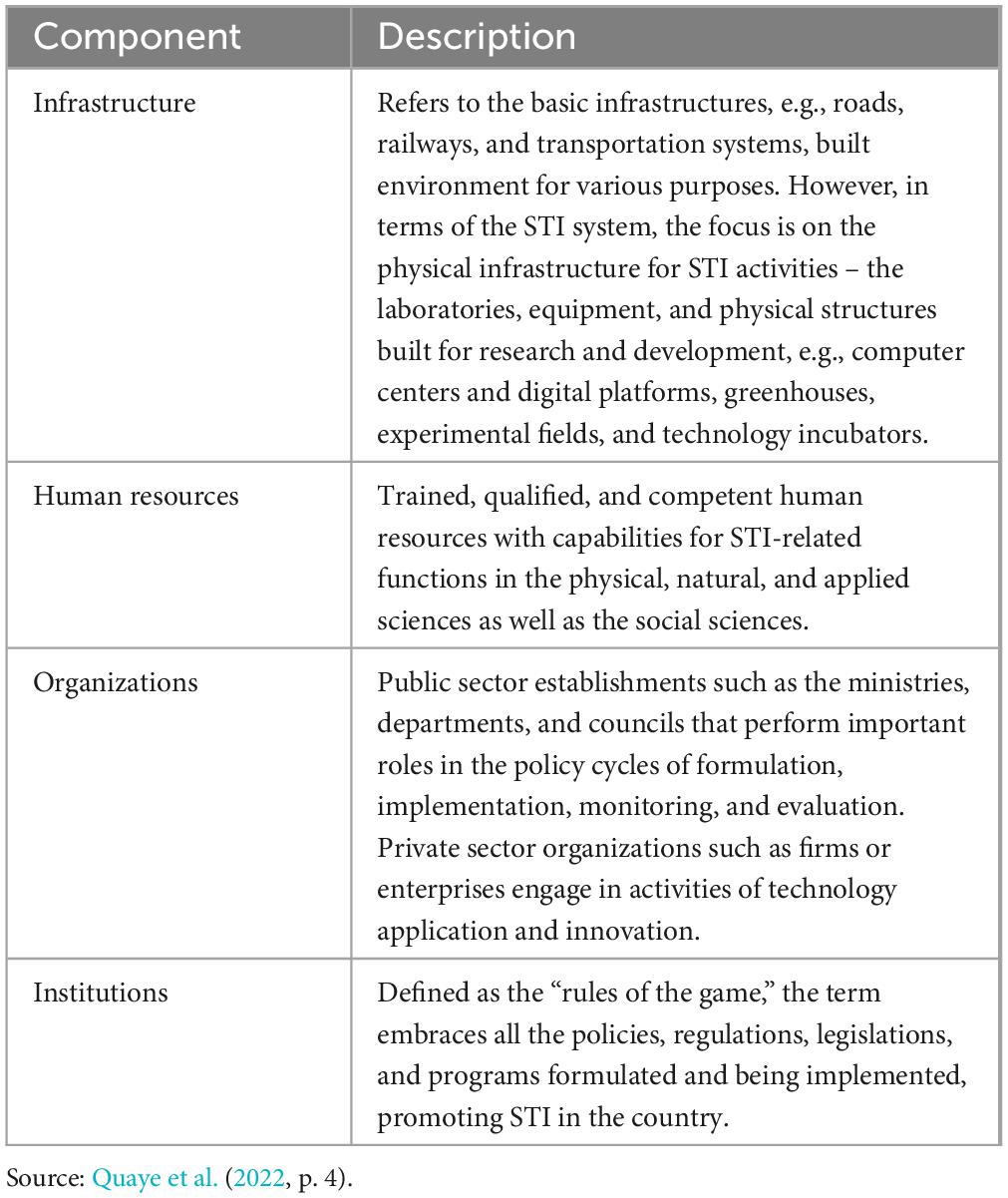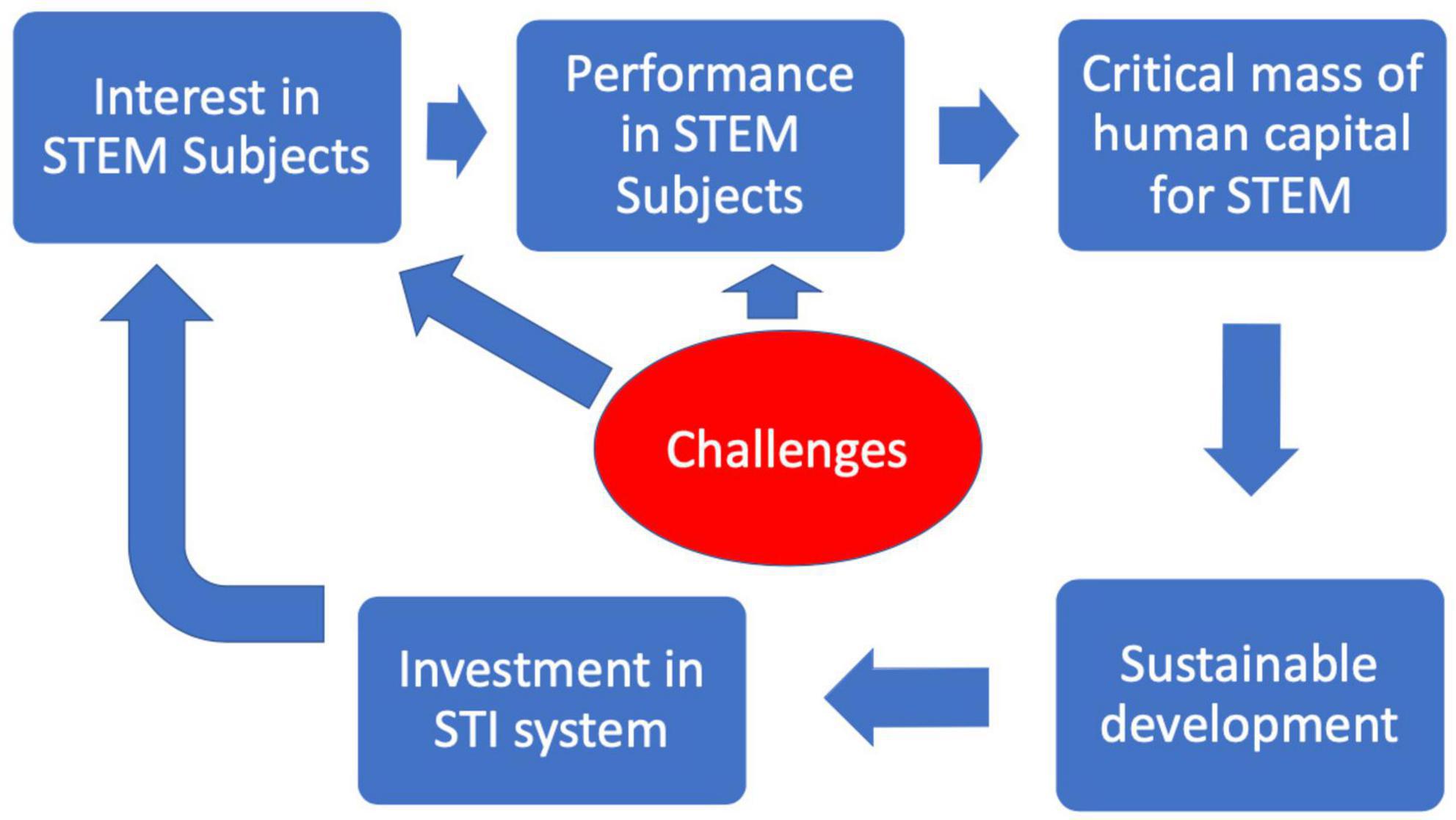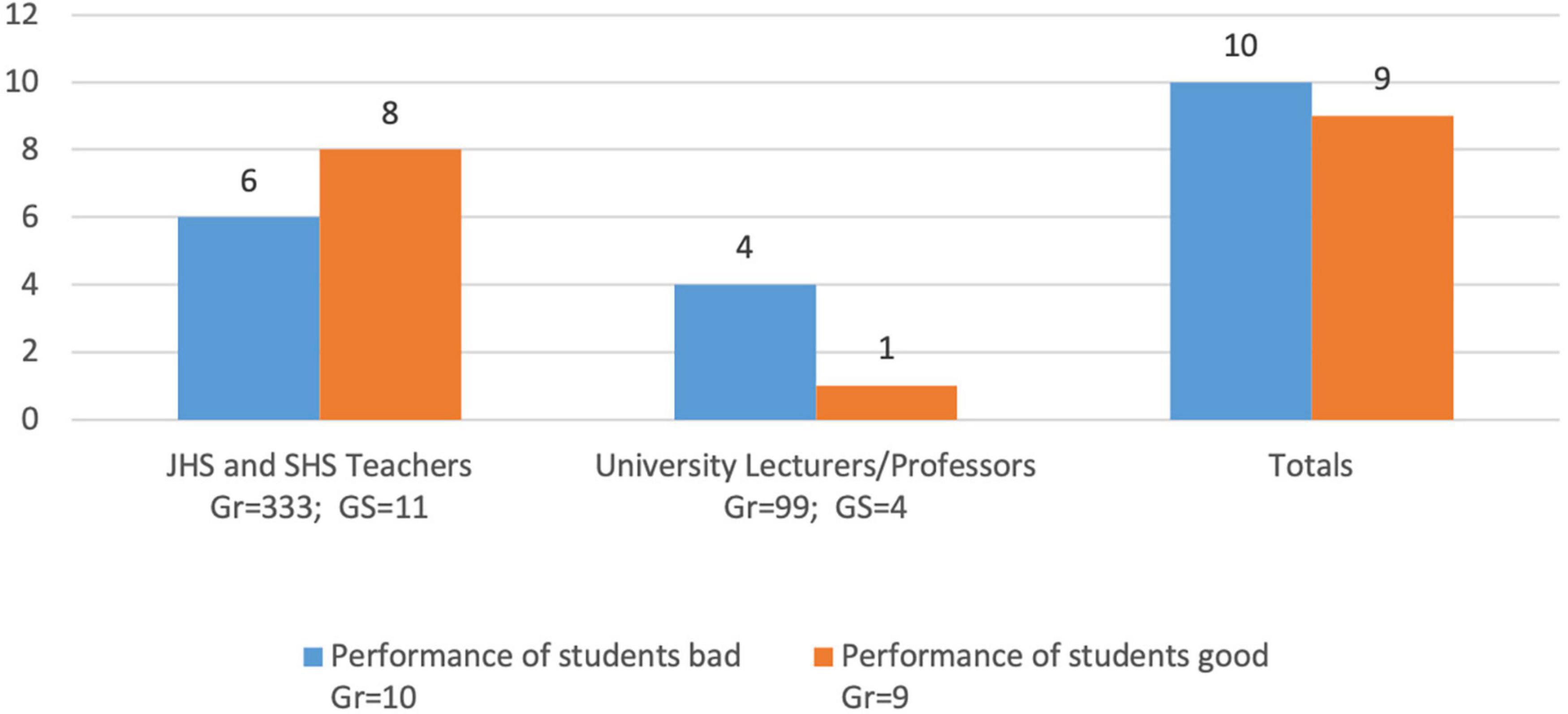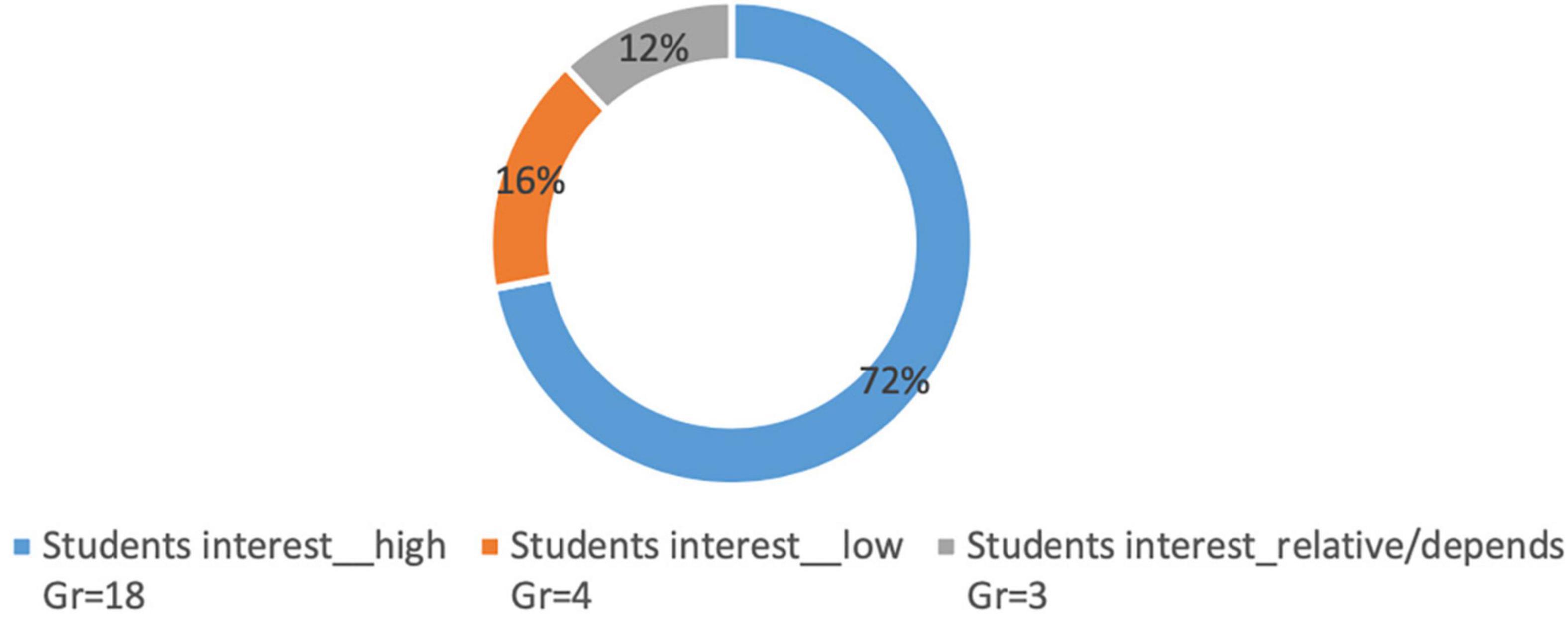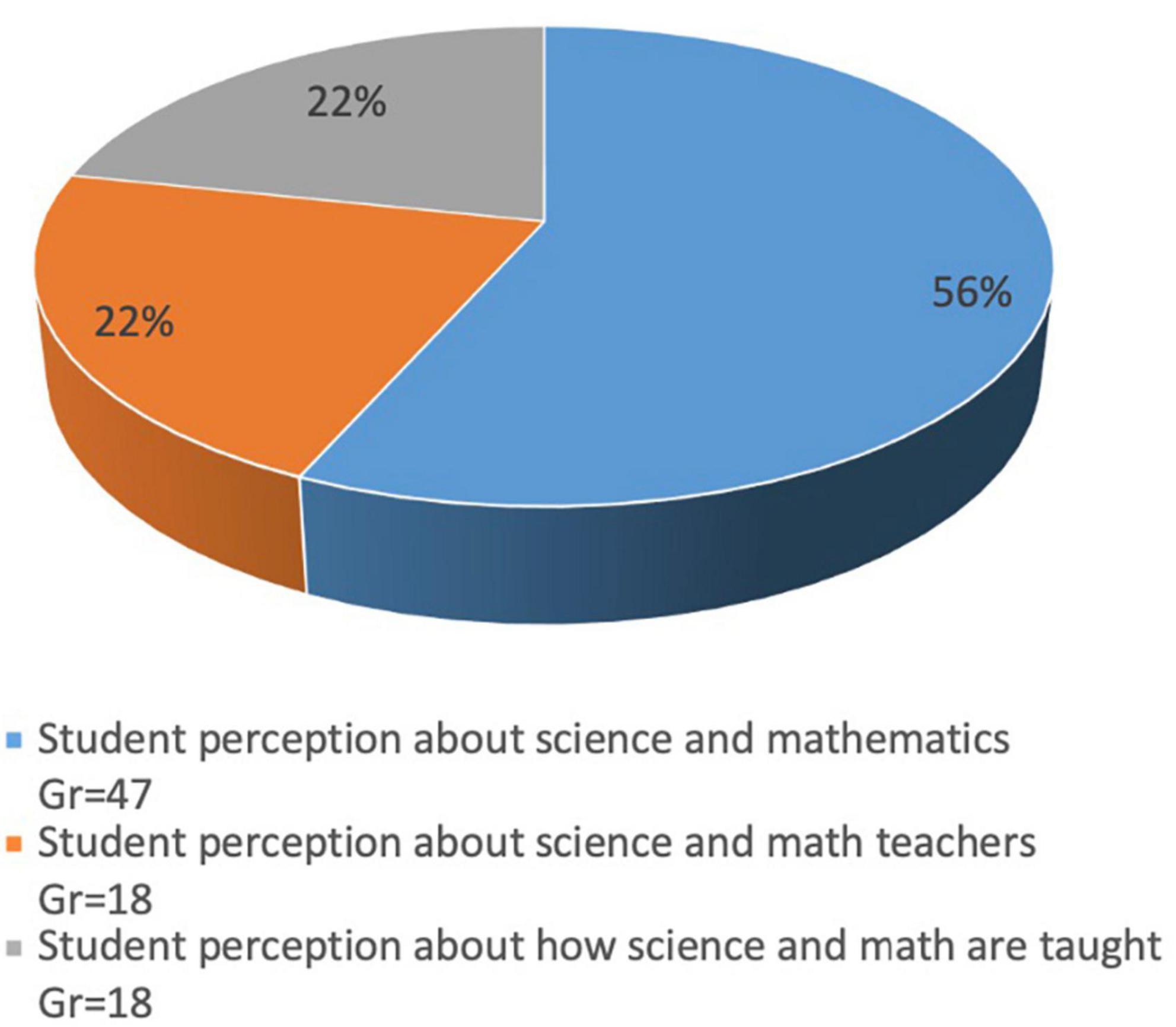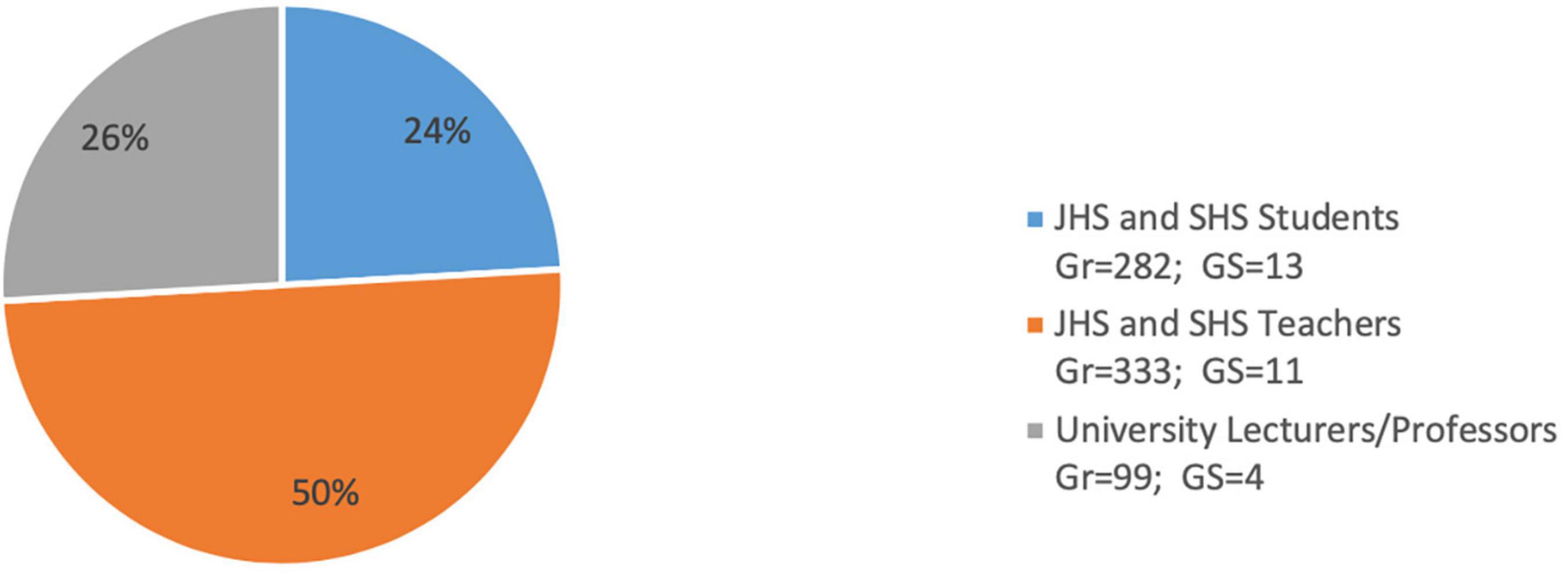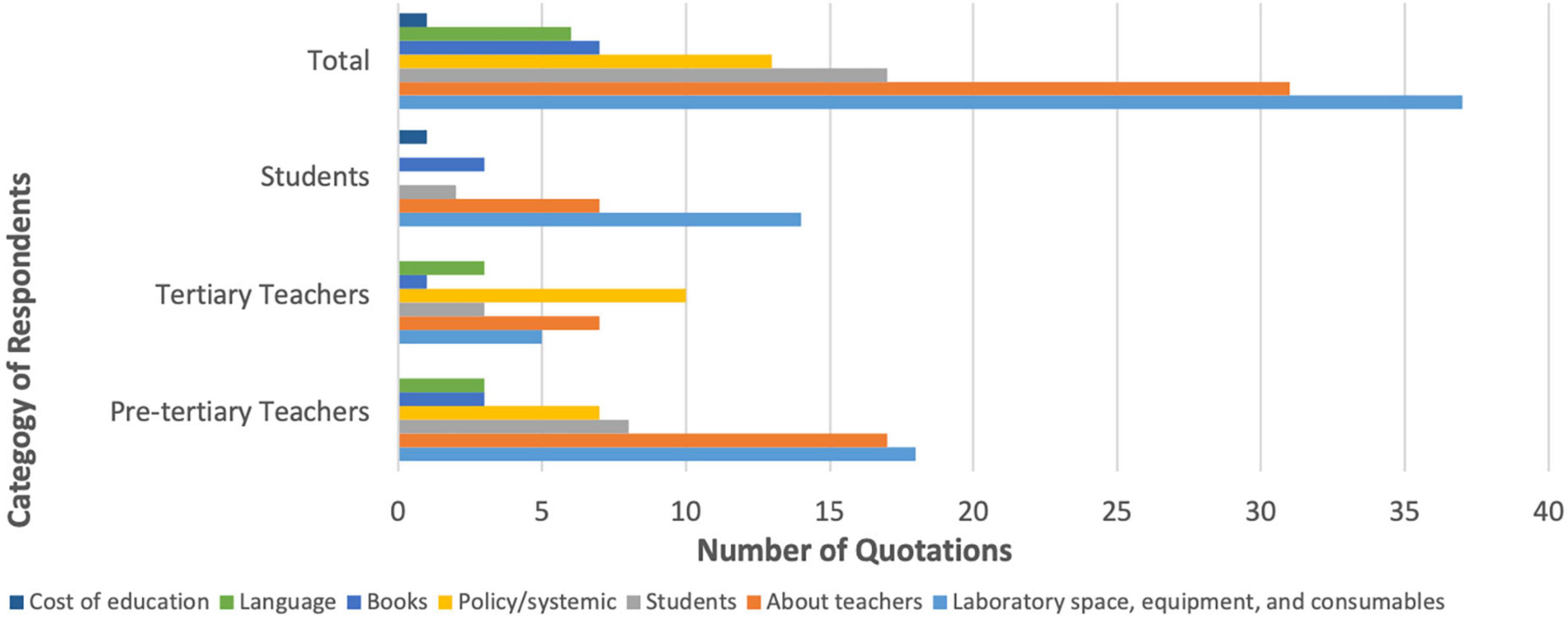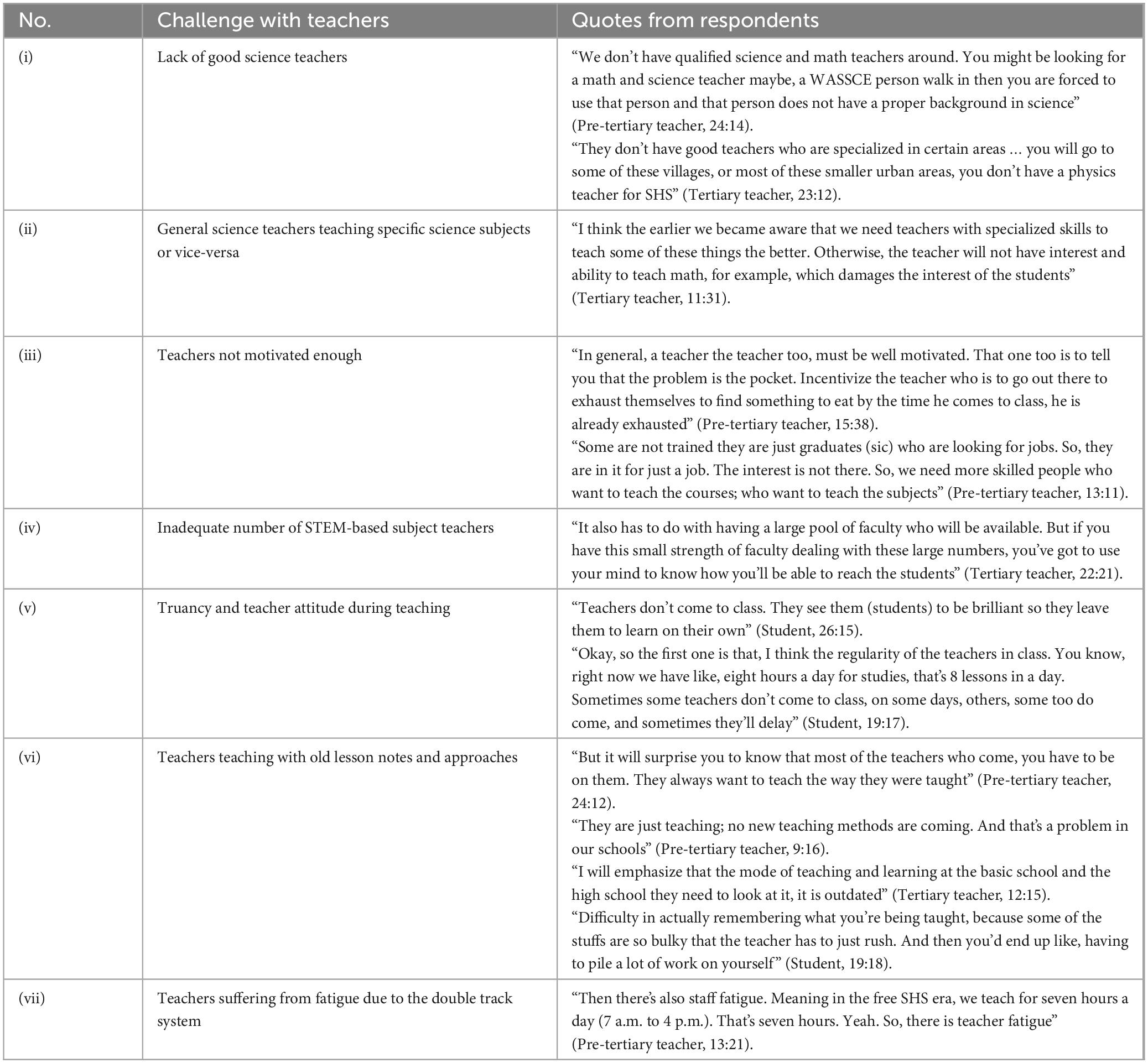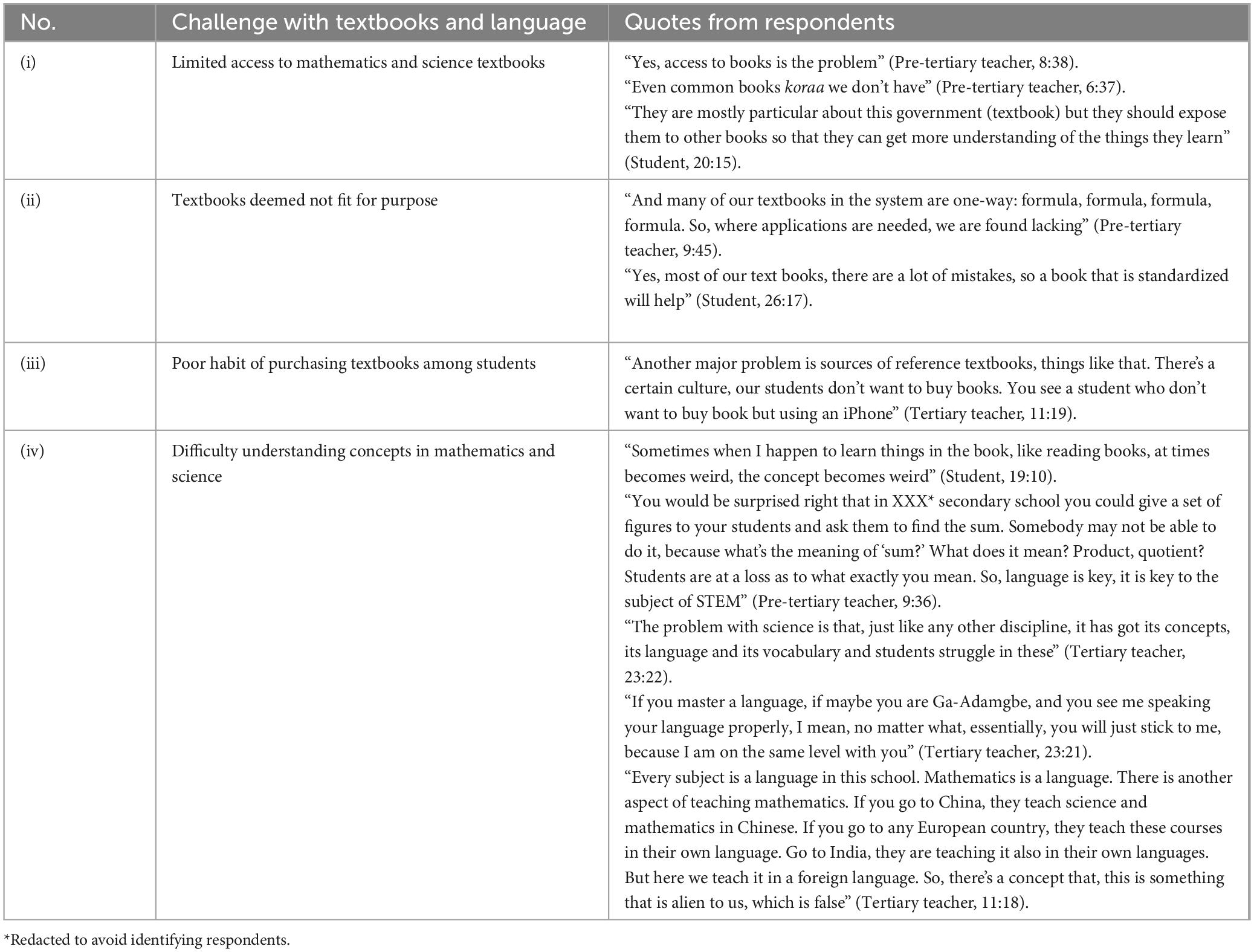- 1CSIR-Science and Technology Policy Research Institute (STEPRI), Accra, Ghana
- 2University Child and Youth Development Centre (UCYDE), Accra, Ghana
- 3College of Arts, Society and Education, James Cook University, Townsville, QLD, Australia
- 4Department of Chemistry, University of Ghana, Accra, Ghana
Ghana has recently renewed its commitment to build a strong Science, Technology, and Innovation (STI) base for improved socio-economic development. This commitment hinges on recognizing that the strength of the nation’s STI policy depends on the quality of pre-tertiary education and training in science and mathematics to produce a critical mass of young people well-prepared for Science, Technology, Engineering, and Mathematics (STEM) courses at the tertiary level. However, despite numerous interventions to improve upon STI, Ghana still performs poorly, along with other Sub-Sahara Africa (SSA) countries with common STI indicators in the Global Innovation Index. Using Ghana as a lens, this article highlights the challenges in STEM teaching and learning throughout the sub-region. The qualitative research approach was adopted to allow an in-depth exploration of participants’ perspectives. Six pre-tertiary schools (three Junior High Schools and three Senior High Schools) and the University of Ghana, Legon, were selected due to the availability of their students and teachers to participate in the interviews in Accra, the capital city. This article argues that, to develop the critical mass of human capital needed for sustainable development, there is a need to improve the performance of students in STEM subjects at the pre-tertiary level. In addition, performance improvement, which is linked to student interest in the study of STEM subjects, should increase the quality of students entering tertiary education institutions. These students will then be trained to meet the quality of human resources needed to run the STI system—a step toward achieving sustainable development this article recommends the redesign of STEM curriculum at the pre-tertiary level to align with tertiary STEM education as that in turn aligns with Ghana’s STI system.
1 Introduction
Recent years have seen conversations around Science, Technology, Engineering, and Mathematics (STEM) education intensify across the globe. This is because STEM has been projected, in many contexts, to drive economic and scientific innovation in society (Sanders, 2012; Martín-Páez et al., 2019; Bertrand and Namukasa, 2020). With these projections, STEM has become popular in discourses on education, industry, innovation, and competition; and caught up with learners from preschool to tertiary levels (Morrison, 2006; Bertrand and Namukasa, 2020). Therefore, the importance of STEM education in the sustainable development of nations cannot be contested (Raheem, 2007).
Consequently, there is recognition of the need to promote STEM education in Ghana. In terms of interventions toward improving STEM education, the 1987 restructuring of Ghana’s education to include an increased focus on mathematics, science, and technology and accompanied by Science, Technology, Mathematics, Innovation, and Education (STMIE) clinics (GSTEP, 2022) deserves mention. Indeed, there have been several interventions with respect to improving STEM education in Ghana—often centered around increasing the number of students in STEM programs (including achieving gender parity); increasing the number of STEM teachers; and increasing/improving the infrastructure for STEM teaching and learning in educational facilities. Also, there have been interventions targeting the educational curriculum in general and toward making it responsive to STEM education, the most recent example being the introduction of STEM senior high schools piloted by five schools across the country. Hence, studies such as Tetteh et al. (2019) and Essegbey et al. (2021) recognize the need to develop the scientific human capital in order to unlock the potential that Science, Technology, and Innovation (STI) possesses for achieving the sustainable development goals (SGDs) and beyond.
However, and despite these previous interventions to improve STEM education, there remain challenges with respect to meeting the human capital needs of the STI system in Ghana. For instance, the recent rankings of the Global Innovation Index (GII) based on global STI indicators show that Ghana’s performance is mixed. Ghana dropped in the rankings of the GII from 96 out of 141 in 2014 to 108 out of 143 in 2015. Between 2016 and 2021, the country’s rankings appeared to stabilize with just marginal movements up and down. However, in 2022, Ghana was ranked 95 out of 132 countries (see Figure 1). The country was ranked 23 among the 34 lower-middle-income economies and 12 among the 27 economies in Sub-Sahara Africa (WIPO, 2022). Indeed, the rankings show that Ghana rated high in areas of creative outputs (creative goods and services and online creativity) and infrastructure [information and communication technologies (ICTs) and general infrastructure]. Still, the country performed worse in other indicators, such as knowledge and technology outputs (knowledge creation, knowledge impact, and knowledge diffusion) and human capital and research [education, tertiary education, research, and development (R&D)].

Figure 1. Ghana’s Global Innovation Index rankings (2009–2022). Source: Global Innovation Index reports.
Given that Ghana’s performance in the GII rankings on human capital and research (education) was poor, it is imperative that measures be put in place to improve STEM education and hence the human capital base for STI. Such measures, however, cannot be formulated in a vacuum without a proper understanding of the challenges facing the teaching and learning of STEM subjects. Indeed, in many ways, Ghana represents several countries in Sub-Sahara Africa (SSA). Therefore, lessons may be learned from the country’s situation to improve on the STI human capital in SSA. In addition, because Ghana is far from meeting its national pre-tertiary and tertiary STEM participation target, there is a need for a deeper understanding of the challenges facing STEM education in Ghana.
Against this background, this article aims to put a spotlight on the challenges facing STEM teaching and learning in a developing economy—Ghana—from the perspectives of students and teachers. Consequently, this article answers three research questions:
1. What are student and teacher perceptions about student performance in science and mathematics?
2. What are student perceptions about science and mathematics as well as about how they are taught?
3. What are the perspectives of students and teachers on the challenges in teaching and learning science and mathematics?
This article is structured as follows: section “2 State of the STI system in Ghana” presents the state of STEM in Ghana by discussing the country’s STI system using the National Innovation System (NIS) concept; the system’s capacity and needs with an emphasis on human capital development; and a discussion of STEM education in Ghana at the secondary school level with secondary data looking at the results of students as well as books per student. Section “3 Theoretical framework” presents and discusses the theoretical framework underpinning the study. Section “4 Materials and methods” describes the research method adopted to generate the data presented in answering the research questions outlined above. In section “5 Findings,” the findings of the study are presented in four sub-sections that include perceptions about the performance of students in science and mathematics; student interest in science and mathematics; perceptions of students about science and mathematics, and teaching; and student and teacher perspectives about challenges of teaching and learning science and mathematics. Section “6 Discussion” discusses the findings in the context of the theoretical framework and contrasting the findings with extant literature. Section “7 Limitations of the study” states the limitations of the study while section “8 Conclusion and recommendations” presents the conclusion.
2 State of the STI system in Ghana
This section delves into the symbiotic relationship between Ghana’s STI system and the cultivation of human capital, with a special focus on the outcomes of STEM education. It seeks to illuminate the pivotal role that skilled human resources play in enhancing the system’s functionality. By drawing connections between quality STEM education and the vitality of the STI system, it provides a comprehensive background, setting the stage for understanding how STEM education serves as a cornerstone for innovation, technological advancement, and national competitiveness within the broader scope of Ghana’s developmental agenda. This exploration not only highlights the importance of investing in human capital but also positions STEM education as a key driver of sustainable growth and innovation in Ghana’s journey toward a knowledge-based economy.
2.1 The NIS concept and Ghana’s STI system
The systemic approach to STI, using the NIS, has a long history going as far back as works in economics, sociology, agricultural sciences, and other disciplines when technology was increasingly becoming the determinant in improving production on farms and in industry. From the literature on the diffusion of technology and innovation to literature on technology as a factor of production, it became evident that technology and innovation are pillars of socio-economic advancement (Schumpeter, 1934; Rogers, 1995). According to Godin (2010), the NIS concept has evolved from early theoretical underpinnings to its present recognition as a framework for analyzing the interplay between science, technology, and national policy. Indeed, according to Lundvall (2007), the NIS concept is relevant for analyzing the linkage of innovation to aggregate national economic performance.
The NIS concept emerged from integrating two perspectives: one viewing innovation as part of the production system, and the other seeing it through the lens of the science and technology system. This fusion aimed to analyze national economic performance, focusing on competitiveness and growth, marking a significant step in understanding the dynamics of innovation within the economic fabric (Lundvall, 2015). Additionally, the literature also underscored technological capability building for economic progress and the NIS in national development (Dosi et al., 1988; Lall, 1996). Consequently, Omri (2020) found that while technological innovation significantly supports all three pillars of sustainable development in high-income countries, its impact is more limited to economic and environmental aspects in middle-income countries, with little to no effect in low-income countries. This has been buttressed by a recent systematic literature review study, which concluded that “countries with knowledge-based economies and learning economies focus strongly on NIS research to foster economic growth, competitiveness and diversification. However, developing countries are also increasingly adopting the innovation systems approach” (López-Rubio et al., 2022, p. 179).
Notwithstanding its utility, there is no simple definition of the concept—its forbearers define it differently. For instance, Freeman (1987) defines it as “the network of institutions in the public and private sectors whose activities and interactions initiate, import, modify and diffuse new technologies” (p. 1); Lundvall (1992) on the other hand defines it as “the organizations and institutions involved in search and exploring such as R&D departments, technological institutes and universities, but also all parts and aspects of the economic structure and the institutional setup affecting learning as well as searching and exploring” (p. 12); while Nelson (1993) defines the concept as “the set of institutions whose interactions determine the innovative performance of national firms” (p. 4). What these definitions project, nonetheless, is the systemic nature of innovation, which allows the concept to serve as a tool for the organization and analysis of the state of scientific and technological readiness for countries to develop. The concept provides an understanding of the interactions and relationships between several actors within the borders of given countries that generate innovation for socio-economic activities (Nelson, 1993; Mytelka, 2000; Lundvall, 2010).
The fundamental systemic perspective on innovation highlights the importance of formulating strategies that will enable an enhancement of innovation within the national borders. Indeed, Ghana has had a long history of evolving its own STI system (Essegbey et al., 2021). Hence, in the discussion of Ghana’s STI system, the NIS concept is adopted as it allows for a holistic approach and permits the formulation of policy options from across different sectors and thematic areas, especially as it relates to industrialization, technological catch-up, and economic performance. Figure 2 illustrates the components of Ghana’s STI system, which relies on the NIS. Human capital is a major component of the system because it represents the trained, qualified, and competent personnel with capabilities for STI-related functions.
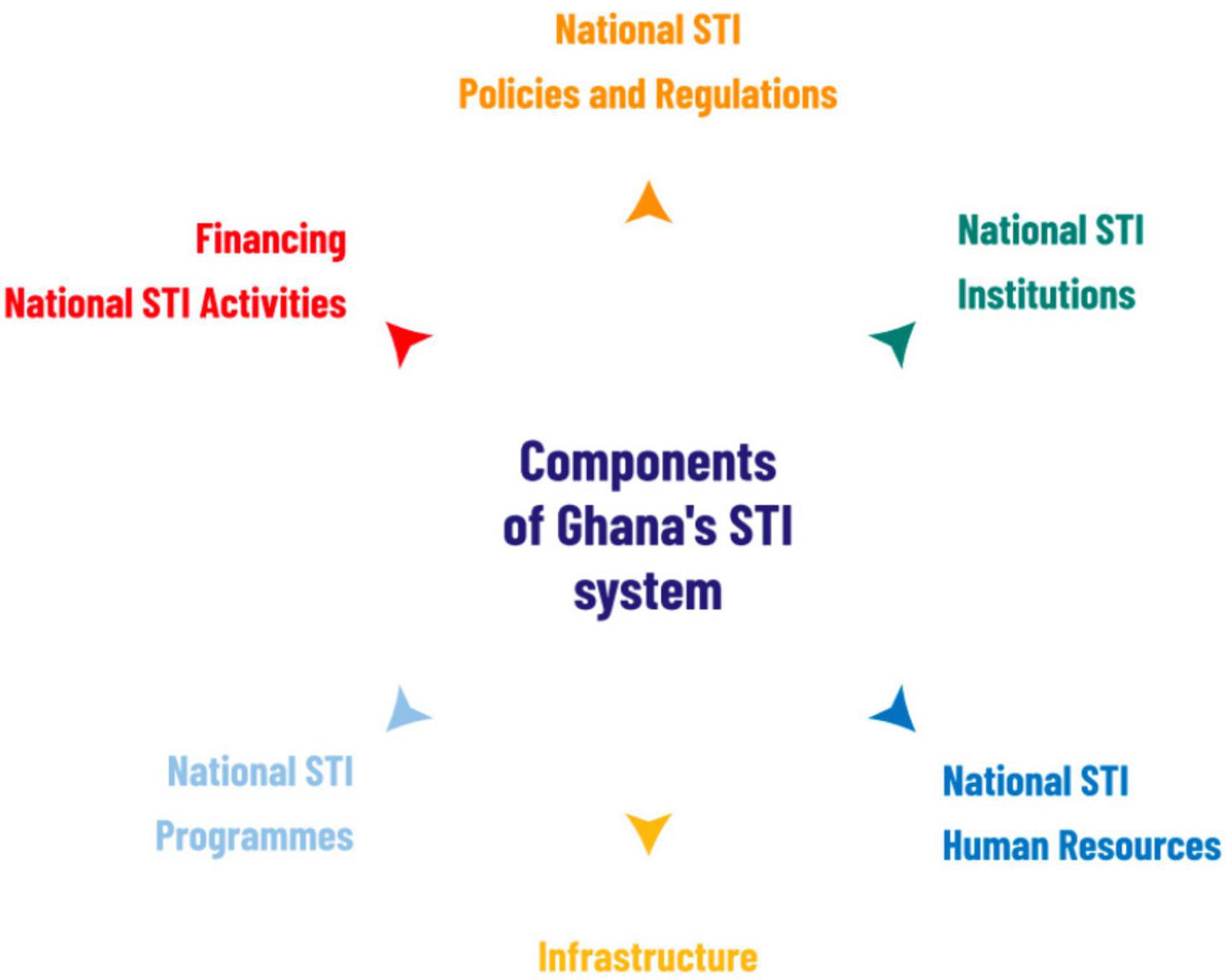
Figure 2. Components of Ghana’s STI System. Source: Essegbey et al. (2021, p. 14).
2.2 Capacity and needs of Ghana’s STI system with emphasis on human capital development
There are various dimensions of STI capacity depending on the point of emphasis. For example, Clipa et al. (2019) discuss innovation absorptive capacity (AC) and innovation development capacity (DC). In both cases, there are the components of basic infrastructure (roads, railways, and other transportation systems, energy systems including electricity supply, educational institutions at all levels), advanced infrastructure (higher education institutions, research institutions, human resources, banks, and other financial institutions), firms (domestic and foreign firms), policies, and formal and informal institutions [regulatory institutions for standards and quality assurance, intellectual property (IP), partnerships and collaboration among actors]. Hence, in conducting the capacity and needs assessment of Ghana’s STI system, Quaye et al. (2022) used four dimensions:
1. physical infrastructure,
2. human resources,
3. organizations in both the public and private sectors, and
4. institutions defined as “rules of the game” (North, 1990, p. 3).
Each of the four dimensions is elaborated on in Table 1.
In respect of overall human capital development, Ghana’s Human Capital Index (HCI13) value for 2020 was 0.44, which suggests that the country’s next generation of workers is expected to be 44% productive. Furthermore, Ghana’s Human Development Index (HDI) value for 2019 was 0.61, with a ranking of 138 out of 189 countries and territories. This puts Ghana in the medium human development category but below the average of 0.631 for countries in the medium human development group. Therefore, strengthening Ghana’s STI system will depend on significant improvement of human capital for STI research and development and other science and technology activities.
A capacity needs assessment conducted by Quaye et al. (2022) reveals a very low postgraduate enrolment in the sciences compared to humanities in the universities. Likewise, female enrolment in PhD programs, as well as in science and engineering programs, was far lower than their male counterparts. The assessment pointed to the need to reorientate the educational system to focus more on science and technology and provide incentives through providing scholarships to attract more students. Any measures aimed at increasing the number of students studying science must be accompanied by measures to get the needed faculty to meet the rising student population.
Often, when STI human capital has been discussed, the focus has been on the tertiary educational level. However, the nature of Ghana’s education system is such that students’ subject areas of study at the tertiary level are pre-determined at the pre-tertiary levels. That is, students in the third (final) year of their Junior Secondary School (JHS) are made to decide whether they intend to study science or non-science subjects at the Senior High School (SHS) level (Ministry of Education, 2022). Upon making the selections, students are unable to change their subjects of study throughout their educational trajectory in the Ghanaian educational system. So, it is important to understand the dynamics of STEM education at the pre-tertiary level.
2.3 STEM education at the pre-tertiary level in Ghana
The Ministry of Education has acknowledged that the current trajectory of STEM education in Ghana is not enough to make the country globally competitive and able to participate fully in the Fourth Industrial Revolution (Ministry of Education, 2022). For instance, the performance of students at the SHS level who sat for science and mathematics has been mixed. As shown in Figure 3, between 2005 and 2020, the percentage of students who passed mathematics at the SHS level increased from 33.3% to 64.4%. However, in between this period, the performance went as high as 71.4% in the 2013–2014 academic year and dropped to as low as 24.2% in the 2007–2008 academic year.
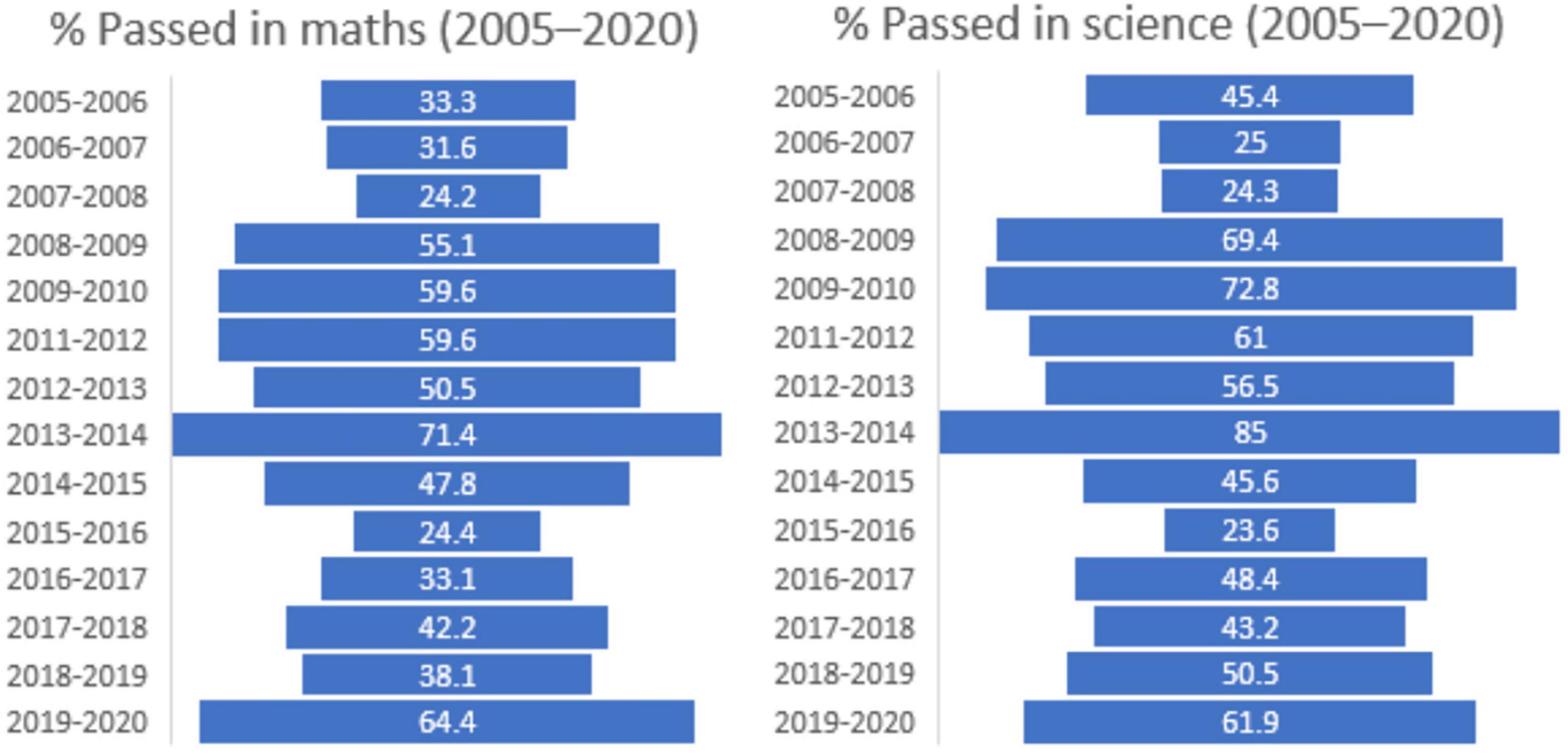
Figure 3. Percent passes in maths and science at SHS level (2005–2020). Source: Compiled from Ministry of Education Reports on Basic Statistics and Planning Parameters for SHSs in Ghana.
Figure 3 shows a similar mixed trajectory in the percentage of students who passed science. The 2013–2014 academic year saw the highest number of passes in science (85%), whereas the 2015–2016 academic year saw the lowest (23.6%). Therefore, some systemic factors may be at play that need to be understood regarding the performance of students in mathematics and science at the SHS level. For instance, student access to science and maths textbooks (Figure 4) does not correspond to student performance, although the ratio of textbooks per student is low. This means other factors must account for student performance over the years.
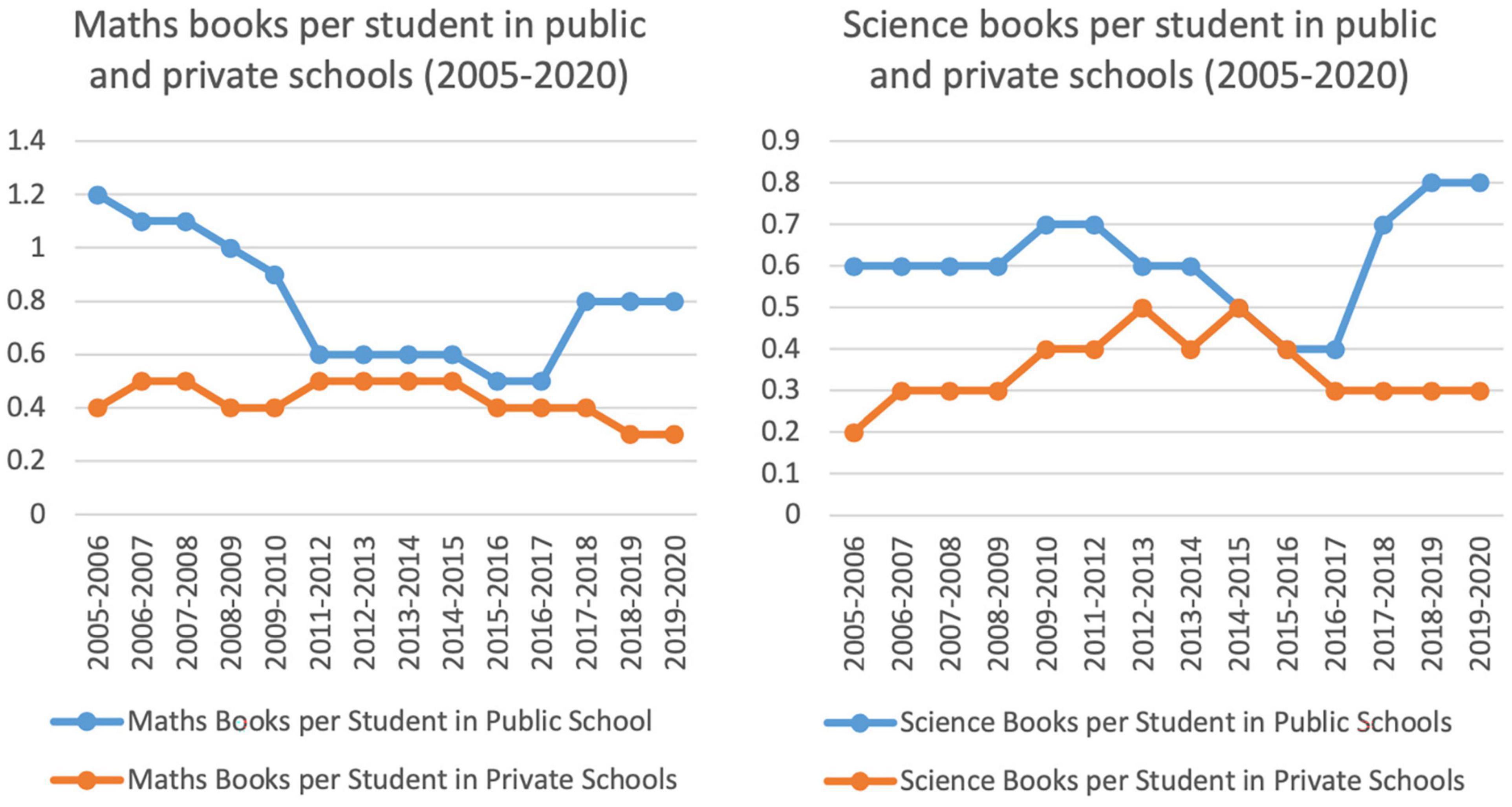
Figure 4. Mathematics and science books per student in public and private schools (2005–2020). Source: Compiled from Ministry of Education Reports on Basic Statistics and Planning Parameters for SHSs in Ghana.
2.4 Scientific human capital and national development
From the foregoing, in order to improve and maintain the performance of SHS students in science and develop the critical mass of human capital needed for Ghana’s STI system, other factors need to be explored. For this article, the focus is on factors that affect student interests and performance in science. As illustrated in Figure 5, this article argues that there is a need to improve student performance in science and mathematics (STEM subjects) at the pre-tertiary level. Performance improvement should lead to an increase in the quality of students entering tertiary education institutions, who will then be trained to meet the quality of human resources needed to run the STI system. This critical mass of human capital is needed for research, development, and innovation (RDI) to achieve sustainable development. With enhanced developmental benefits from the STI system comes increased investments in the STI system that would, in turn, generate more interest in STEM. This article argues that interest in studying STEM subjects is key to improving student performance. However, the linkages simplified in Figure 5 are heavily impacted by challenges that need to be understood and addressed.
The focus on human capital follows from Lundvall (2007) who argued that the significance of human capital in the innovation system is more pronounced than before, and that facets of the innovation system that foster competence building are increasingly vital for a nation’s performance, thus, underscoring the pivotal role of human capital in driving innovation and sustaining competitive advantage in a globalized world. So, the NIS concept has been outlined above to provide the theoretical context within which Ghana’s STI system is defined and which the conclusions of this article would be applied. However, the theoretical framework underpinning the article is the Sociocultural Theory of Education as developed by Vygotsky (1978), which emphasizes that learning is deeply embedded in social interactions, cultural settings, and contextual factors.
3 Theoretical framework
The Sociocultural Theory of Education is relevant as it offers a lens to scrutinize the complex landscape of STEM education within Ghana. It underscores the significance of social dynamics and cultural contexts in crafting educational experiences and achievements. Through this theoretical lens, the study dissects how Ghana’s cultural ethos, societal anticipations, and educational milieu tailor STEM pedagogical and learning modalities. Moreover, it advocates for interventions aimed at not merely refining the curriculum but also ameliorating social engagement and tailoring educational methodologies to Ghana’s unique cultural milieu, aiming to elevate STEM educational standards.
The theory suggests that development and learning are deeply embedded in social and cultural activities, highlighting the importance of guided participation and the transformation of participation in sociocultural activities. Furthermore, and most importantly, the theory underlines the significance of language and other semiotic means in the learning process, where these tools mediate social and individual functioning, facilitating the co-construction of knowledge (Polly et al., 2018).
In mediation through cultural tools, Vygotsky (1978) argues that language is crucial for the development of higher mental functions, facilitating cognitive processes such as problem-solving, abstract thinking, and conceptual understanding, which are essential in STEM education (Polly et al., 2018). Language acts as a tool for cognitive development, enabling individuals to internalize and manipulate complex concepts. Moreover, it facilitates social interaction and collaborative learning, which Vygotsky identifies as key components of cognitive development. Through interaction with more knowledgeable peers and adults, learners construct new knowledge, with language serving as the medium for this social and cognitive engagement. This perspective underscores the significance of language in transforming external information into internal cognitive structures, thereby playing a pivotal role in learning STEM subjects.
Thus, the theory offers a robust framework for understanding the challenges and opportunities in STEM education within Ghana. The necessity of enhancing SHS students’ performance in science and mathematics to cultivate a critical mass of human capital is essential for Ghana’s national system of innovation. This approach aligns with Vygotsky’s emphasis on the role of educational and societal contexts in shaping learning processes and outcomes. Improving student interest and performance in STEM is crucial for national development, which resonates with Vygotsky’s view on the transformative power of education shaped by cultural and social contexts. Addressing the challenges impacting students’ interest and performance requires a multifaceted approach that considers the cultural, social, and linguistic factors intrinsic to the Ghanaian educational landscape. This sociocultural perspective provides a lens through which interventions can be designed to not only refine the STEM curriculum but also enhance the social engagement and pedagogical strategies, making them more relevant and effective within the unique Ghanaian context.
4 Materials and methods
In order to answer the research questions outlined earlier, this article adopts a qualitative research approach where pre-tertiary education level students were engaged in in-depth interviews. In addition, pre-tertiary teachers and lecturers at the tertiary level were interviewed. In total, 28 key informant interviews were carried out, as outlined in Table 2. As Tremblay (1957, p. 688) points out, the key informant interview technique for data collection “is pre-eminently suited to the gathering of the kinds of qualitative and descriptive data that are difficult or time-consuming to unearth” using other data collection techniques such as a questionnaire survey. In view of the approach to data collection, this article does have limitations regarding quantification and interviewee selection (Kumar, 1989). Nonetheless, the advantages that the key person interview technique provides, such as the ability to obtain “information directly from knowledgeable people” (USAID, 1996, p. 2), make this article stronger in allowing for in-depth exploration of perspectives of respondents in respect of the challenges of teaching and learning STEM subjects.
The interviews were carried out between May and October 2022 in the capital city of Accra. Six pre-tertiary schools (three JHSs and three SHSs) and the University of Ghana, Legon, were purposely selected due to the availability of their students and teachers to participate in the interviews. For the pre-tertiary level, the students were selected at random, if they studied science and mathematics, to participate in the interviews. If there was more than one science and/or maths teacher, they were selected by means of simple random selection for interview. The university lecturers were purposely selected based on their perceived familiarity with the subject matter as well as their availability. During the interviews, the Principal Investigator (PI) was aided in the interviews by two interview guides that were prepared to facilitate the discussions. The interview guide contained statements that directed the interview. One interview guide was for students (JHS and SHS) while the other interview guide was for pre-tertiary teachers (JHS and SHS) and tertiary teachers (professors).
The interviews were recorded with the permission of the interviewees and the audio recordings were later transcribed, with anonymity taken into consideration, by a research assistant. The transcribed text files were imported into ATLAS.ti Mac (Version 9.1.3) (Scientific Software Development GmbH, 2021) for analysis. In analyzing, the PI read through each transcribed text to familiarize himself with the texts and then proceeded to code the texts in vivo by marking significant text segments with codes that represent key concepts or themes emerging from the data. Subsequently, and as patterns emerged, the codes were organized into a coherent framework by grouping similar codes into categories. This step was iterative to ensure that the codes and categories were refined. Atlas.ti’s Quotation Manager and Code Frequency Analysis tools were used to quantify the frequency with which certain themes or concepts appear.
4.1 Ethical considerations
This study was spearheaded by the University Child and Youth Development Centre (UCYDE), a not-for-profit organization. The UCYDE is not required to submit this study to an ethics committee; indeed, UCYDE does not have an ethics committee. However, to ensure that the research followed ethical protocols, each research participant interviewed was assured of the confidentiality of the interview and the non-disclosure of the data with their identities. In addition, each respondent was informed that the interview was voluntary and that they could decline to participate in the interview should they decide to leave at any time. Written informed consent was obtained from each research participants (for teachers) or legal representative (for students) before interviews were conducted. No research participant withdrew prematurely from the study.
5 Findings
5.1 Perceptions about student performance in science and mathematics
A person’s perception of their status in society is an important factor that determines what measures they intend to put in place to either maintain or improve their status. Hence, understanding the perceptions that teachers have about student performance gives an indication as to whether teachers are satisfied with the status quo or whether they think more needs to be done to improve student performance. Hence, in addressing the first research question, the study asked teachers (including university lecturers) what they thought about pre-tertiary student performance in science and mathematics.
As illustrated in Figure 6, the overall perception of teachers (by way of quotations) is that student performance is good. However, when these quotations are disaggregated between pre-tertiary and tertiary teachers, the results are remarkably different. Pre-tertiary teachers find the level of performance to be good (eight quotations, 57%), while the reverse is found by tertiary teachers (lecturers), with four quotations (80%) indicating student performance is bad.
One pre-tertiary teacher that found student performance to be good claimed that “oh yes, I can give about 90 and above yes, they are well versed in mathematics, science and IT” (JHS teacher, 17:10) while another claimed that “Over the years, they [students] do well. All my chemistry students, those who have finished school got first class at KNUST [Kwame Nkrumah University of Science and Technology] and at Cape Coast [University of Cape Coast], they do very well. They do very well” (SHS teacher, 8:28). For the university teachers (lecturers) who believe the performance is bad, one claimed that
over the years, my experiences are that we are having consistent degradation of students’ performance, particularly at the entry level. You know, you don’t know, sometimes at faculty meetings, we discuss this quite a lot as to what is happening at the basic levels, the [senior] high school level, what has changed; because, you know, they come in and you’re expecting some level of performance.” (Tertiary teacher, 12:3)
Another claimed that “yes, and I will say that we really are not happy or expect that kind of chemistry” (Tertiary teacher, 23:6).
This outcome implies that while most teachers at pre-tertiary are satisfied with the level of student performance, teachers at the tertiary level are not satisfied. Hence, there is a gap in the understanding of the level of quality and performance required to undertake tertiary education in STEM subjects. If teachers at the pre-tertiary level, through the curriculum, demonstrate an understanding of what is required of students at the tertiary level, then there would be a smooth transition for students from pre-tertiary education to tertiary education in STEM. All these are from the point of view that the pre-tertiary teacher ought to appreciate either by themselves and/or through the educational curriculum at that level; however, as illustrated in the conceptual framework of this article, students’ performances (ceteris paribus) is also linked to whether students are interested in science and mathematics or not.
5.2 Student interest in science and mathematics
As Figure 7 illustrates, there is a perception that pre-tertiary students have a high interest in mathematics and science. For instance, one tertiary teacher remarked that “those who actually get caught up in the aspect of understanding will always want to fully get involved. You see them chasing you to ask more questions. Which is very interesting” (Tertiary teacher, 22:18). A pre-tertiary teacher also observed that “our final year, those who have completed, out of 16 students 13 people are offering science and only three are not offering science. So, it means they have interest in it” (Pre-tertiary teacher, 16:5).
From this study, there is no doubt that students at the pre-tertiary level have an interest in science and mathematics; however, this article argues that such level of interest is contingent on the perceptions that students have about science. This is the second research question guiding the article.
5.3 Student perceptions about science, mathematics, and teaching
This study assumes that the underlying basis for student interest in STEM subjects (mathematics and science) is their perceptions about the subjects. Therefore, students were asked about these perceptions. Following the analysis, most of the quotations obtained in respect of student perceptions related to the two subjects (56%), followed by their perceptions about teachers (28%) and how science and mathematics are taught (28%), as shown in Figure 8. In terms of student perception of science and mathematics as subjects they are taught, the overwhelming majority of the quotations showed positive attitudes toward the two subjects, albeit some had mixed feelings about the subjects. Such mixed feelings were based on what students had heard others say about science and mathematics and not necessarily their own feelings.
Those with positive attitudes felt that science, for instance, is quite a dignified subject that commands respect from students who study it, and therefore, science carries with it a certain feeling of prestige. Some students found science to be “interesting.” As one of the interviewees said, “I think science is an interesting subject and when it comes to the composition of science, that is physics, chemistry, I do elective geography not the biology and all come together to make science and makes it an interesting subject” (SHS student, 28:2). Another student who had a positive attitude toward science was of the view that science is about everyday life. The student said, “I really like science. So, in the science lessons, most of the time when we are talking about [science], I feel we are talking about our life and daily activities” (Pre-tertiary student, 25:8). A student was of the view that science is an opening to understanding new things about the world, saying that “there is a lot of new things to find out in science. And when you learn about some things, it is very interesting. I mean studying science exposes you to new things” (Pre-tertiary student, 21:3). The positive perceptions students had about science were further exemplified when a student was of the view that science had taught her how to grow food:
for example, the science we learn, in my class we learn farming system[s]. So, if you want to farm, you can learn different ways of farming like crop rotation, land rotation. There are other ways you can learn to farm, and the tools which you use to farm to help you in farming. (Pre-tertiary student, 2:3)
Regarding student perception about how they were taught science and mathematics, most were of the view that the teaching was too theoretical and did not involve laboratory or demonstration work to make the subjects more appealing. Even the textbooks did not provide detailed descriptions and drawings for illustrations. On too much theoretical teaching, a student noted that
Well, in [my] school there is more of theory than actual practicals. So instead of you having a feel of science or what you are studying; for example, when it comes to forces, a topic like magnetism, instead of experimenting with the magnet and the metallic object, you will just be given a diagram and they will use lines and other elements of design to illustrate to you the magnetic force around it and that isn’t easy to take in. (Pre-tertiary student, 28:7)
On mathematics, another student mentioned that
In mathematics, we are given a problem on the [black]board, and everyone tries their hands on it. So, let’s say one person doesn’t get it properly, then our teacher goes back and teaches all of us in the class the steps in which we’ll do it so that everyone can be able to understand it, not leaving one person. (Pre-tertiary student, 2:9)
Science and maths lessons being too theoretical without demonstrations makes understanding the subjects difficult. This was the main contention of one of the students who said that “because some of the things we don’t see it practically, it makes sometimes understanding it [the lessons] difficult. It looks very abstract. Whether you understand it or not, you take it like that” (Pre-tertiary student, 21:5). From the foregoing, it appears that one of the challenges affecting science and mathematics teaching and learning in Ghana is the overemphasis on theory. However, this challenge is birthed by other challenges that teachers and students face in Ghana’s educational system.
5.4 Student and teacher perspectives on the challenges of teaching and learning
The following section answers the third research question of the article about the perspectives of students and teachers on challenges in teaching and learning science and mathematics. A total of 112 quotations were obtained from the study where interviewees mentioned challenges facing STEM education in Ghana. Of that number, pre-tertiary (JHS and SHS) teachers made 50% of those quotations; tertiary teachers made 26% of the quotes; and students (JHS and SHS) produced 24% (Figure 9). Figure 10 shows that most of the quotations were challenges in respect of limited or lack of laboratory space, equipment for demonstrations, and consumables (33%). This was followed by quotations on challenges relating to teachers (31%); challenges relating to students (17%); systemic issues that negatively affect STEM education (12%); challenges concerning books (6%); language (5%), and cost of education (1%).
5.4.1 Inadequate laboratory space, equipment, and consumables
On the lack of laboratory space, a pre-tertiary teacher’s point of view was that
the main one [challenge] has to do with in terms of science, space, because science is mainly lab, laboratory [work]. Because I can imagine the time I was leaving [secondary school], there were many classes; we were having about 10 [science classes]. But now, we could be more than that since they [Ministry of Education] introduced the double track system and we have three or four chemistry labs for about 10 plus classes. How are you going to plan to engage them during practical [sessions]? (Pre-tertiary teacher, 15:34).
On the same score of inadequate laboratory space and equipment, another teacher who teaches ICT was of the view that
it is lack of the resources in terms of apparatus. If you come to our school like this, as we speak, we have ICT laboratory without a single computer and we are teaching ICT…. Every day the teachers teach ICT, what are they teaching in the first place? Right? So, the whole thing is abstract. It makes the whole teaching difficult” (Pre-tertiary teacher, 8:32–33).
A student’s perspective on how the limited laboratory space and equipment affect their learning of ICT stated that “the computers and devices are too old. They lack some features and functions like the modern ones. So due to this, you can’t perform all the necessary operations on the device in the lab on the computer” (Student, 20:23). Yet, another student, when commenting about chemistry, was of the view that “when it comes to chemistry, some of the chemicals, sometimes they are not available and it takes time to actually get them on board” (Student, 19:20).
5.4.2 Challenges regarding teachers
Challenges regarding teachers was the next category identified by the respondents. Some of the specific issues mentioned included (i) lack of good science teachers; (ii) general science teachers teaching specific science subjects or vice-versa, e.g., an integrated science teacher teaching elective chemistry or a chemistry teacher teaching integrated science; (iii) teachers not motivated enough (externally by employers and internally by their desire to teach instead of seeing teaching as a job); (iv) inadequate number of STEM-based subject teachers; (v) truancy and teachers’ attitude during teaching, e.g., rushing the lessons to make up for lost time; (vi) teachers teaching with old lesson notes and approaches instead of adopting approaches that meet the “nature of students in this day”; and (vii) teachers suffering from fatigue due to the double track system. Table 3 summarizes some of the quotations to buttress the challenges enumerated regarding teachers.
5.4.3 Challenges regarding books and language
Although quotations on challenges concerning books and language together constitute 11% of all the quotations on challenges, it is interesting to find respondents talking about language as a challenge to learning STEM subjects. This has, therefore, warranted the need to highlight these two (books and language). Another reason for the need to highlight books and language is that they have not been considered together in a synergistic manner when addressing challenges to STEM education. Inadequate science and mathematics books have often been a challenge and interventions have been developed to address it. But this has not been done in tandem with language, which makes it an imperative to consider the two together in this article.
Challenges identified relating books include (i) limited access to mathematics and science textbooks (which is corroborated by Figure 4); (ii) textbooks deemed not fit for purpose; and (iii) poor habit of purchasing textbooks among students. On the part of language, the only challenge identified has to do with how students struggle to understand concepts in mathematics and science. Table 4 summarizes the challenges and quotations by respondents.
6 Discussion
The differing perceptions of student performance in science and mathematics between pre-tertiary and tertiary educators, as highlighted in the findings offer a compelling lens through the Sociocultural Theory of Education. The divergence in perceptions underscores the sociocultural disconnect between the educational stages, reflecting varying expectations and understandings of academic readiness and performance standards. This scenario aligns with research indicating that teachers’ expectations and perceptions significantly influence student achievement, mediated by the cultural and institutional contexts of education (Rubie-Davies, 2015). The gap between pre-tertiary and tertiary educators’ views may stem from distinct sociocultural dynamics and expectations within each educational level, impacting how student performance is evaluated and addressed. Furthermore, the study’s findings resonate with the importance of aligning educational curricula and teaching practices across levels to ensure a smooth transition of students into tertiary education, particularly in STEM subjects. This alignment is crucial for developing the necessary human capital to support national development in science and technology sectors, emphasizing the role of education in fostering a society’s scientific and technological progress (Marginson et al., 2013). Thus, addressing the perceptual disparities through a sociocultural lens involves not only curriculum alignment but also fostering a shared understanding of educational objectives and standards across educational levels, highlighting the role of social and cultural factors in shaping educational experiences and outcomes. Additionally, aligning pre-tertiary and tertiary education within the broader context of Ghana’s STI system is essential for nurturing the human capital necessary for national development in science and technology. The systemic approach to innovation, as the NIS, underscores the need for a cohesive educational strategy that enhances STEM outcomes and addresses the sociocultural dynamics at play. By fostering a shared understanding of educational objectives and standards, informed by the NIS’s focus on human capital and the sociocultural theory’s emphasis on social interactions and cultural context, Ghana can effectively prepare students for the demands of its evolving STI system. This approach not only bridges the perceptual disparities between educational stages but also supports the development of a skilled workforce capable of contributing to sustainable socio-economic advancement.
The interest in science and mathematics among pre-tertiary students, as presented in the findings aligns with Vygotsky’s Sociocultural Theory, emphasizing the role of social interaction and cultural context in fostering learning interest. This theory suggests that students’ interest in STEM fields can be significantly influenced by the social environment, including teacher enthusiasm, peer encouragement, and societal valuation of these disciplines (Vygotsky, 1978). The engagement and curiosity demonstrated by students in pursuing further knowledge in these subjects underscore the importance of supportive educational practices and the cultural valorization of science and mathematics. These observations are supported by the literature, indicating that a supportive learning environment, characterized by positive teacher attitudes and active learning opportunities, can enhance students’ interest in and engagement with STEM subjects (Palmer et al., 2015). This further implies that cultivating a culture that values inquiry and curiosity within educational settings can significantly contribute to sustaining students’ interest in STEM. Furthermore, the findings on pre-tertiary students’ interest in science and mathematics reflect the sociocultural dimensions of Ghana’s NIS, emphasizing the critical role of human capital development in the STI system. This alignment illustrates how societal, educational, and policy frameworks collectively influence students’ enthusiasm for STEM subjects. The NIS concept, on which basis the STI system in Ghana elaborated, underscores the importance of nurturing a supportive social and educational environment to foster students’ interest. The engagement of students in STEM, influenced by the broader sociocultural and policy landscape, highlights the necessity for a holistic approach to education that bridges the gap between theoretical knowledge and practical applications, ensuring a robust human capital pipeline for Ghana’s STI ambitions.
The positive attitudes toward science, as seen through the lens of students considering it a subject of prestige and relevance to everyday life, highlight the influence of societal values and cultural perceptions on student engagement and interest in STEM subjects. Conversely, the critique of overly theoretical teaching points to a gap between educational practices and the sociocultural needs of learners, suggesting a need for more practical, hands-on experiences that connect theoretical knowledge with real-world applications. These findings corroborate (Freeman et al., 2014) who suggest that active learning strategies can significantly enhance understanding and interest in STEM. Therefore, integrating practical demonstrations and real-life applications into STEM education, as advocated by the sociocultural theory, could bridge the gap between student perceptions and effective learning.
Given the challenges in teaching and learning STEM as outlined in the findings, it is evident that the material and social conditions of the learning environment significantly influence the educational process. This perspective is supported by a broad range of literature that explores the interplay between sociocultural factors and STEM education. According to Vygotsky (1978), cognitive development is deeply embedded in social contexts and that learning occurs through interactions within these contexts. The challenges mentioned, such as inadequate laboratory space and equipment, and the need for more qualified teachers, Bardoe et al. (2023) can be viewed as limitations in the social and material scaffolding necessary for effective STEM learning. This aligns with findings from Henze et al. (2008), who argue that the availability of adequate resources and teacher expertise are crucial for facilitating science education that is both meaningful and contextually relevant to students. The systemic approach of the NIS, highlighting the interplay between technological capability, innovation, and socio-economic advancement, underscores the necessity for improving STEM education as a foundational pillar for national development. Addressing challenges such as inadequate resources and the need for more qualified STEM educators becomes imperative within this framework, emphasizing the alignment of educational strategies with the broader objectives of the NIS to foster a conducive environment for innovation and sustainable growth.
The issue of language as a barrier to learning STEM subjects further underscores the importance of considering sociocultural dynamics in education. Language not only mediates learning but also reflects the cultural practices and values of a community (Lee and Buxton, 2010). This suggests that addressing language barriers in STEM education requires a culturally responsive approach that values students’ linguistic backgrounds as assets rather than obstacles. Moreover, the challenges regarding books and the emphasis on theoretical rather than practical learning resonate with the critique by Aikenhead (1996) on the disconnection between scientific knowledge taught in schools and its application in everyday life. This disconnection calls for mitigation measures that include adopting a sociocultural approach to STEM education that bridges classroom learning with students’ real-world experiences and cultural backgrounds. This imperative aligns with Ghana’s NIS with respect to developing the human capital the STI system. Integrating practical, real-world applications in STEM curricula can bridge the gap between theoretical learning and everyday life, enhancing Ghana’s global competitiveness and readiness for the 4th Industrial Revolution. This approach, rooted in the sociocultural dynamics of education, stresses the importance of a learning environment that values cultural and linguistic diversity, fostering hands-on STEM experiences vital for nurturing the necessary human capital for Ghana’s STI system.
7 Limitations of the study
Given the methodology employed for data collection and the narrow scope of research participants, the findings of this study might not be broadly applicable across different contexts. While the results find support in existing educational statistics from the Ministry of Education and extant literature, it is important to exercise caution in extending these findings universally. The limited participant pool suggests the need for further research to confirm these outcomes across more diverse and extensive demographics to ensure the robustness and wider relevance of the study’s conclusions.
8 Conclusion and recommendations
The study articulates the perspectives between pre-tertiary students and educators, and tertiary educators regarding student performance in STEM, through the Sociocultural Theory of Education. The divergence in perceptions mirrors the sociocultural disparities across educational stages, influenced by varying expectations and academic standards. This discrepancy is rooted in differing sociocultural dynamics, underscoring the need for curriculum alignment to bridge these gaps, essential for nurturing human capital critical to Ghana’s STI system. The study’s findings, against the backdrop of Ghana’s NIS, emphasize the systemic approach to STI, where technological innovation and human capital development play pivotal roles in socio-economic advancement. Aligning educational curricula and teaching methods is crucial for a seamless transition into tertiary education, fostering a conducive environment for STEM learning that aligns with societal and technological advancements. This alignment, coupled with an understanding of sociocultural dynamics, is pivotal for enhancing STEM education, contributing to the development of a skilled workforce that supports national development.
This article set out to answer three research questions: (i) What are student and teacher perceptions about student performances in science and mathematics; (ii) What are student perceptions about science and mathematics subjects; and (iii) What are teacher and student perspectives on challenges of teaching and learning science. In respect of the first research question, the general perception among pre-tertiary teachers and students was that student performance in science and mathematics was good. This is not surprising in the sense that students and teachers would be biased in a subjective assessment of their own performance, albeit their perception is corroborated by the results of passes of students in science (62%) and mathematics (64%) for the year 2020.1 However, the perceptions of pre-tertiary teachers and students greatly contrast with the perceptions of tertiary teachers, which is that student performance has been poor. The conclusion to be drawn is that there is a misunderstanding between pre-tertiary teachers and tertiary teachers in respect of the quality of students desired at the tertiary level to pursue STEM. This gap ought to be addressed with the redesign of the STEM curricula at the pre-tertiary level of education to match the requirements for pursuing higher education in STEM and the curricula at the tertiary level of education. This curricula redesign must align with the strategies of the broader national STI system to prepare the human capital needed for the Fourth Industrial Revolution.
In respect of the second research question, this article concludes that student perceptions of science and mathematics were positive. Students had a positive appreciation and desire to study science and mathematics because they thought that it was dignifying to be regarded as a science student and that the study of science broadened one’s world. On the other hand, students had a generally negative perception of how science and mathematics were taught in their schools. Hence, given the desire among students to study these STEM subjects, measures ought to be put in place to improve the delivery of lessons by teachers and to maintain student interest in studying science. It is crucial for Ghana’s STI system to enhance teaching methods and sustain student interest in science through professional development for teachers to adopt more engaging and practical teaching strategies and curriculum adjustments to make STEM education more appealing and relevant to students’ experiences and aspirations. This aligns with the study by Quansah et al. (2020) who found that students who were exposed to science and mathematics were most likely to develop interests and subsequently pursue STEM in the future.
Teachers and students identified several challenges facing teaching and learning STEM subjects, including limited or lack of laboratory space, equipment for demonstrations, and consumables; challenges relating to teachers; challenges relating to student behavior; systemic issues that negatively affect STEM education; challenges concerning books; and language. While the last two challenges had fewer quotations than the others, they ought to be highlighted in the sense that access to books with the appropriate content is critical to mastery of the “language” of science. Therefore, as a “low-hanging fruit” option, efforts should be made to support the provision of adequate STEM books to students in Ghana.
From the foregoing, the following policy recommendations emanate from the study:
• Align the STEM curriculum at pre-tertiary levels with tertiary education requirements and the broader national STI strategy to prepare students for higher education and the demands of the Fourth Industrial Revolution.
• Increase investments in continuous professional development programs for teachers to adopt more engaging, practical, and culturally relevant teaching strategies that align with students’ experiences and aspirations.
• Address the critical shortage of laboratory space, equipment, and adequate STEM books in schools to support hands-on learning and improve mastery of STEM subjects.
• Facilitate a structured dialogue and collaboration between pre-tertiary and tertiary educators to harmonize expectations and academic standards across educational stages.
• Expand national campaigns and educational programs that highlight the value and opportunities within STEM fields to maintain and increase student interest and enrolment in science and mathematics.
Furthermore, we recommend future studies to consider:
• Studies that include a broader demographic of students and educators across different regions and school types to enhance the generalizability of the findings.
• Conducting long-term research to examine how changes in STEM education policies and practices impact student performance and interest over time.
Data availability statement
The raw data supporting the conclusions of this article will be made available by the authors, without undue reservation.
Ethics statement
Ethical approval was not required for the study involving humans in accordance with the local legislation and institutional requirements. Written informed consent for participation in the study was obtained from the teachers and/or from the students’ legal representatives.
Author contributions
GA: Conceptualization, Data curation, Formal analysis, Funding acquisition, Investigation, Methodology, Project administration, Supervision, Visualization, Writing – original draft, Writing – review & editing. GF: Conceptualization, Formal analysis, Funding acquisition, Investigation, Visualization, Writing – original draft. KT: Conceptualization, Funding acquisition, Investigation, Supervision, Writing – original draft, Writing – review & editing. RKA: Conceptualization, Investigation, Supervision, Writing – original draft, Writing – review & editing. WQ: Conceptualization, Formal analysis, Investigation, Supervision, Writing – review & editing. DN: Conceptualization, Investigation, Writing – original draft, Writing – review & editing.
Funding
The author(s) declare financial support was received for the research, authorship, and/or publication of this article. This study was funded by the University Child and Youth Development Centre (UCYDE) and CSIR-Science and Technology Policy Research Institute, Accra, Ghana.
Acknowledgments
The authors wish to express their gratitude to the research participants (students and teachers) from the selected basic and secondary schools in Accra as well as the participants from the University of Ghana. Gratitude also goes to Mr. Asaan Bukari and Ms. Elizabeth Nana Oye our research assistants. Finally, we wish to thank those who reviewed and provided comments to the draft manuscript.
Conflict of interest
The authors declare that the research was conducted in the absence of any commercial or financial relationships that could be construed as a potential conflict of interest.
Publisher’s note
All claims expressed in this article are solely those of the authors and do not necessarily represent those of their affiliated organizations, or those of the publisher, the editors and the reviewers. Any product that may be evaluated in this article, or claim that may be made by its manufacturer, is not guaranteed or endorsed by the publisher.
Footnotes
- ^ There were no statistics for the year in which the study was carried out.
References
Aikenhead, G. S. (1996). Science education: Border crossing into the subculture of science. Stud. Sci. Educ. 27:52. doi: 10.1080/03057269608560077
Bardoe, D., Hayford, D., Bio, R. B., and Gyabeng, J. (2023). Challenges to the implementation of STEM education in the Bono east region of Ghana. Heliyon 9:e20416. doi: 10.1016/j.heliyon.2023.e20416
Bertrand, M. G., and Namukasa, I. K. (2020). STEAM education: Student learning and transferable skills. J. Res. Innov. Teach. Learn. 13, 43–56. doi: 10.1108/jrit-01-2020-0003
Clipa, R. I., Ifrim, M., and Clipa, F. (2019). An assessment of regional innovation capacity as a factor of economic growth of Romanian regions. Timisoara J. Econ. Bus. 12, 227–242. doi: 10.2478/tjeb-2019-0012
Dosi, G., Freeman, C., Nelson, R., Silverberg, G., and Soete, L. (1988). Technical change and economic theory. Pisa: Laboratory of Economics and Management (LEM), Sant’Anna School of Advanced Studies.
Essegbey, G. O., Quaye, W., Agyeman, A., Akon-Yamga, G., Safo, N. K., Asafu-Adjaye, N. Y., et al. (2021). Science technology and innovation (STI) ecosystem in Ghana. Paris: UNESCO.
Freeman, S., Eddy, S. L., McDonough, M., Smith, M. K., Okoroafor, N., Jordt, H., et al. (2014). Active learning increases student performance in science, engineering, and mathematics. Proc. Natl. Acad. Sci. U.S.A. 111, 8410–8415. doi: 10.1073/pnas.1319030111
Godin, B. (2010). National innovation system: A note on the origins of a concept. Montreal, QC: INRS.
GSTEP (2022). Practical STEM education in Ghana: Barriers and opportunities. Accra: Ghana Science and Tech Explorer Challenge Prize (GSTEP).
Henze, I., van Driel, J. H., and Verloop, N. (2008). Development of experienced science teachers’ pedagogical content knowledge of models of the solar system and the universe. Int. J. Sci. Educ. 30, 1321–1342. doi: 10.1080/09500690802187017
Kumar, K. (1989). Conducting key informant interviews in developing countries. A.I.D. Program design and evaluation methodology report No. 13 (Issue 13). Washington, DC: USAID.
Lall, S. (1996). Learning from the Asian tigers: Studies in technology and industrial policy. London: Macmillan.
Lee, O., and Buxton, C. A. (2010). Diversity and equity in science education: Research, policy and practice. New York, NY: Teachers College Press.
López-Rubio, P., Roig-Tierno, N., and Mas-Verdú, F. (2022). Assessing the origins, evolution and prospects of national innovation systems. J. Knowledge Econ. 13:161. doi: 10.1007/S13132-020-00712-7
Lundvall, B. Å (1992). National systems of innovation: Towards a theory of innovation and interactive learning. London: Pinter.
Lundvall, B. Å (2007). Innovation system research where it came from and where it might go. GLOBELICS working paper series (2007–01; GLOBELICS working paper series). Aalborg: Aalborg University, doi: 10.7135/UPO9781843318903.016
Lundvall, B. Å (2010). National systems of innovation: Toward a theory of innovation and interactive learning. London: Anthem Press, doi: 10.1057/9780230512603
Lundvall, B. -Å (2015). “The origins of the national innovation system concept and its usefulness in the era of the globalizing economy,” in Proceedings of the 13th Globelics conference 2015 in Havana September 23-26, (Aalborg).
Marginson, S., Tytler, R., Freeman, B., and Roberts, K. (2013). STEM: Country comparisons: International comparisons of science, technology, engineering and mathematics (STEM) education. Melbourne, VIC: Australian Council of Learned Academies.
Martín-Páez, T., Aguilera, D., Perales-Palacios, F. J., and Vílchez-González, J. M. (2019). What are we talking about when we talk about STEM education? A review of literature. Sci. Educ. 103, 799–822. doi: 10.1002/sce.21522
Morrison, J. (2006). TIES STEM education monograph series: Attributes of STEM education – The student, the academy, the classroom. Cleveland, OH: Teaching Institute for Excellence in STEM.
Mytelka, L. K. (2000). Local systems of innovation in a globalised world economy. Ind. Innov. 7, 15–32.
Nelson, R. (1993). National innovation systems: A comparative analysis. Oxford: Oxford University Press.
North, D. C. (1990). Institutions, institutional change and economic performance: Political economy of institutions and decisions. Cambridge: Cambridge University Press.
Omri, A. (2020). Technological innovation and sustainable development: Does the stage of development matter? Environ. Impact Assess. Rev. 83:106398. doi: 10.1016/j.eiar.2020.106398
Palmer, D., Dixon, J., and Archer, J. (2015). Changes in science teaching self-efficacy among primary teacher education students. Aust. J. Teach. Educ. 40, 26–40. doi: 10.14221/ajte.2015v40n12.3
Polly, D., Casto, A. R., Norwood, J., and Allman, B. (2018). “Sociocultural perspectives of learning,” in Foundations of learning and instructional design technology, ed. R. E. West (Provo, UT: EdTech Books).
Quansah, F., Rosemary Ankoma-Sey, V., and Aframea Dankyi, L. (2020). Determinants of female students’ choice of STEM programmes in tertiary education: Evidence from senior high schools in Ghana. Am. J. Educ. Learn. 5, 50–61. doi: 10.20448/804.5.1.50.61
Quaye, W., Agyeman, A., Akon-Yamga, G., Safo, N. K., Asafu-Adjaye, N. Y., Ayeduvor, S., et al. (2022). Capacity and needs assessment of Ghana’s science, technology and innovation (STI) system for the implementation of the 2017 UNESCO recommendation on science and scientific researchers. Accra: UNESCO.
Raheem, K. T. (2007). “Failing education systems in Africa?” in Educational issues for sustainable development in Africa, eds K. T. Raheem, P. Kupari, and J. Lasonen (Jyväskylä: University of Jyväskylä), 9–16.
Rubie-Davies, C. M. (2015). Becoming a high expectation teacher: Raising the bar. Milton Park: Routledge.
Sanders, M. (2012). “Integrative STEM education as “best practice”,” in Explorations of best practice in technology, design, & engineering education, Vol. 2, ed. H. Middleton (Brisbane, QL: Griffith Institute for Educational Research), 103–117.
Schumpeter, J. A. (1934). The theory of economic development: An inquiry into profits, capital, credit, interest, and the business cycle. London: Transaction Publishers.
Scientific Software Development GmbH (2021). ATLAS.ti scientific software. Berlin: Scientific Software Development GmbH.
Tetteh, E. K., Akon-Yamga, G., Jumpah, E., and Omari, R. (2019). Scientific human resource for national development in Ghana: Issues and challenges. Afr. J. Sci. Technol. Innov. Dev. 10, 1–12. doi: 10.1080/20421338.2019.1596396
Tremblay, M. A. (1957). The key informant technique: A nonethnographic application. Am. Anthropol. 59, 688–701. doi: 10.1525/aa.1957.59.4.02a00100
Vygotsky, L. S. (1978). Mind in society: The development of higher psychological processes. Cambridge, MA: Harvard University Press.
Keywords: STEM, education, Ghana, challenges, actors’ perspective
Citation: Akon-Yamga G, Funkor G, Tsey K, Kingsford-Adaboh R, Quaye W and Ntewusu DA (2024) Perspectives from students and teachers about the challenges of teaching and learning STEM subjects in Ghana. Front. Educ. 9:1288413. doi: 10.3389/feduc.2024.1288413
Received: 04 September 2023; Accepted: 10 April 2024;
Published: 23 April 2024.
Edited by:
Samiksha Raut, University of Alabama at Birmingham, United StatesReviewed by:
Teresa Maria Dias Paiva, Polytechnic Institute of Guarda, PortugalPedro Tadeu, Polytechnic Institute of Guarda, Portugal
Copyright © 2024 Akon-Yamga, Funkor, Tsey, Kingsford-Adaboh, Quaye and Ntewusu. This is an open-access article distributed under the terms of the Creative Commons Attribution License (CC BY). The use, distribution or reproduction in other forums is permitted, provided the original author(s) and the copyright owner(s) are credited and that the original publication in this journal is cited, in accordance with accepted academic practice. No use, distribution or reproduction is permitted which does not comply with these terms.
*Correspondence: Gordon Akon-Yamga, eWFtZ2ExNkBnbWFpbC5jb20=
 Gordon Akon-Yamga
Gordon Akon-Yamga Godfried Funkor
Godfried Funkor Komla Tsey
Komla Tsey Robert Kingsford-Adaboh
Robert Kingsford-Adaboh Wilhemina Quaye
Wilhemina Quaye Diana Amoni Ntewusu
Diana Amoni Ntewusu